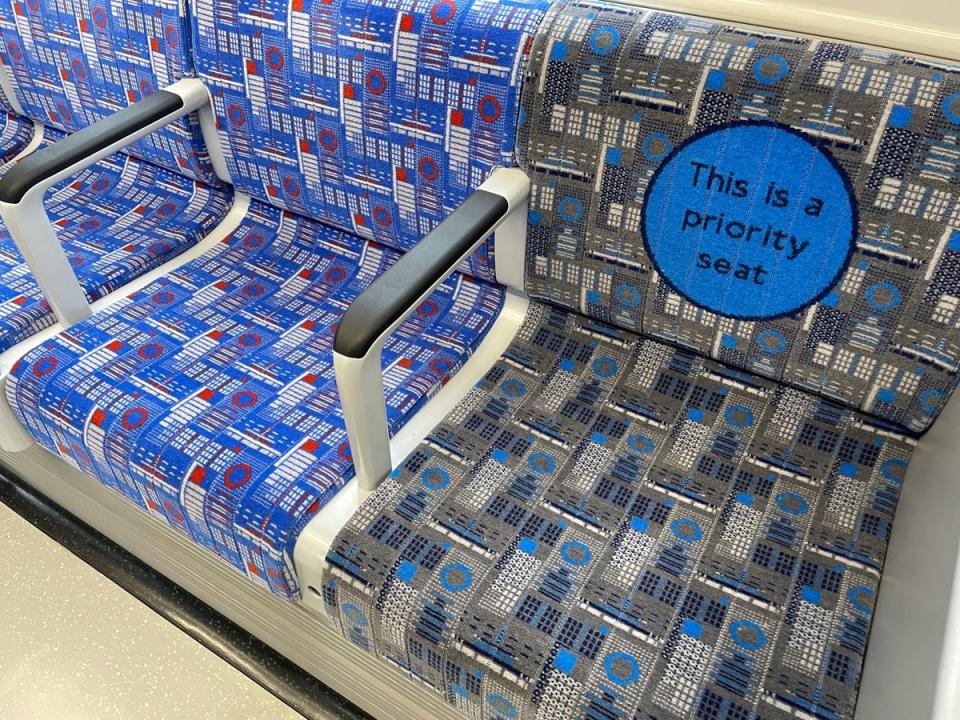First look inside new Piccadilly Line trains as they undergo testing ahead of 2025 rollout
The first new Piccadilly line trains have entered testing – and are due to start running in London in two years.
Transport for London bosses say the 94 new trains will transform one of the Tube’s busiest lines, increasing capacity by 10 per cent.
They will also be the first deep-level “walk through” trains on the Underground - and the first with air conditioning.
A new moquette seat pattern has been designed for the trains, named Holden in honour of Charles Holden, the London Underground architect between the 1920s and 1940s who changed the face of the capital with iconic stations such as Arnos Grove and Southgate.
TfL executives hope the Bakerloo line will be the next to get new trains – which are now considered a greater priority than upgrading the track and signalling system on the Piccadilly line to maximise the benefit of the new £1.5bn fleet.
The Evening Standard was invited to travel on one of the first Piccadilly line trains to undergo “extensive” testing at manufacturer Siemens’ depot in Wildenrath in north-west Germany.

Glynn Barton, chief operating officer for Transport for London, said the upgrade was delivering “leaner, greener trains for London”.
It is due to be completed by May 2026, when the last of the new trains is expected to enter service.
Mr Barton said: “The current Piccadilly line trains are at the end of their life. They have been around for nearly 50 years. It’s time to replace them.”
He declined to name a launch date. “We have got to make sure they are absolutely fit for purpose before we allow passengers on, but testing is going brilliantly,” he said.
The new trains will have nine carriages, rather than six at present - with some carriages longer than others. The doors will be wider to allow easier boarding and exiting.
The new trains will have a notional capacity of 1,042 passengers - about 10 per cent more than the 1973 stock, of which there are 86 trains.
But the difference in the train geometry requires TfL to "shave" some station platforms to create more space and prevent collisions.
New signalling on the line - which is used by more than one in 10 Tube passengers - would allow up to 36 trains an hour at peak times. At present, there are 24 trains an hour. The new trains will initially run at up to 27 an hour.
Stuart Harvey, chief capital officer at TfL, said: “We need to re-signal the Piccadilly line. A, because it’s coming up to be life-expired, and also to bring in latest digital signalling technology, so we can get trains closer together and run a greater service.”
New signalling would require more trains. TfL has an option to order a further 18 Piccadilly line trains from Siemens – and also wants it to build a fleet of new Bakerloo line trains, but needs Government funding guarantees before it can place an order.
The trains on the Bakerloo line are up to 51 years old. Asked if he was forced to choose between new trains on the Bakerloo and new signalling on the Piccadilly, Mr Harvey said: “That is a difficult question, but we desperately need funding for Bakerloo line trains.
“They’re as old as the existing Piccadilly line trains. We have to replace them – otherwise it’s going to be an uphill struggle to continue to maintain them. They’re not a ‘nice to have’. They’re essential.”
TfL's immediate request is for £500m from the Government to pay for major projects in 2024/25.
Asked whether there was a risk to the new Piccadilly line trains if this was not received, Mr Harvey said: “It’s not impossible but it’s too early to say.”

If the new Bakerloo line trains are to be built at Goole, TfL needs to place an order by 2026 – and also have infrastructure such as a new Bakerloo line depot in progress by then.
Sambit Banerjee, joint chief executive of Siemens Mobility, said about 60 per cent of the Piccadilly line trains would be built in Goole and the remainder in Vienna, Austria. He said the new trains had a shelf life of at least 25 years.
He said: “We will test-run this train for another six or seven months. We will bring the first train to London in the summer of 2024, and then in 2025 TfL will start the passenger service.”
He added: “We have put a lot of engineering effort into making the passenger journey more comfortable. These are articulated trains, so passengers can spread across the train – there is no overcrowding at any point.
“The seats are very comfortable. The height is greater. The doors are wider, and that helps for easy access. We think that Londoners will enjoy [them].
“Then there is the ‘icing on the cake’ – the first air-cooled train for London Underground. We really hope that this makes Londoners feel happy.”


